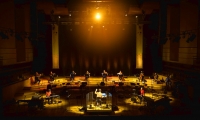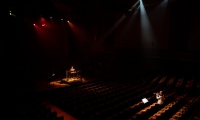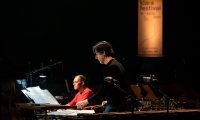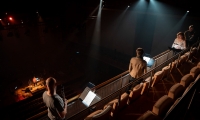ICTUS WITH

Synergy Vocals

Orchestre de l’Opéra national de Lorraine

TOM DE COCK
PROGRAMME
CHARLES IVES: THE UNANSWERED QUESTION [1908, 6']
For string orchestra, solo trumpet and group of four wind instruments
STEVE REICH: PROVERB [1995, 15']
For five voices, percussion and electronic keyboards
GAVIN BRYARS: THE SINKING OF THE TITANIC [1972, 16']
For string ensemble and tapes (sounds, voices and recorded music)
STEVE REICH: TEHILLIM [1981, 32']
In four movements. For four voices, six percussionists and large ensemble
Concert without intermission. Total time: 70 minutes.

CAST
Tom De Cock, conductor
SYNERGY VOCALS
Sopranos in Proverb and Tehillim
Micaela Haslam, Caroline Jaya-Ratnam, Rachel Weston
Alto in Tehillim
Heather Cairncross
Tenors in Proverb
Benedict Hymas, Gerard O’Beirne
ICTUS
Chryssi Dimitriou: flutes
Dirk Descheemaeker: clarinet
Kristien Ceuppens: oboe
Géry Cambier: double bass
Jean-Luc Fafchamps, Jean-Luc Plouvier: keyboards
Miquel Bernat, Gerrit Nulens, Ruben Orio, Aya Suzuki: percussion
Alexandre Fostier, sound engineer
Antoine Delagoutte, sound assistant

production
Production & distribution:
Ictus Ensemble
Originally coproduced with:
Brussels Philharmonic
Proverbs presents a panorama of four 20th century ‘minimalist’ masterpieces, chosen for their introspective quality.
The programme was assembled around Steve Reich's undisputed masterpiece, TEHILLIM. Inspired by the Psalms of David, Tehillim marks a moment of grace along the American composer’s path, with the work finding a magical balance between repetitive and hypnotic rhythms on one end, and the complex rhythms of Hebrew prayer on the other.
At the other end of the spectrum, revealing another meaning of ‘minimalism’, Gavin Bryars’ THE SINKING OF THE TITANIC dives into a conceptual and narrative – almost cinematographic – sound space, tinged with boundless melancholy.
Carefully lit, amplified and mixed in quadraphonic sound, this concert is more than the sum of its parts. It is conceived as a poetic and almost narrative moment (... the key here is the “almost”!). Without focusing on their meaning, but purely relying on the power of musical expression, the chosen works and their dialogue bring to life a “theatre in music”, a palette of sensitive ideas that mirror our most pressing concerns: the place of humans on Earth, the lies we tell ourselves, the possibility of collective suicide, and singing praise for the world’s beauty. Each of the work’s four scenes is linked to the next.
Scene I – Charles Ives: The Unanswered Question
From the very first second, this 1908 strange and sublime work seizes the listener’s attention, and builds a narrative structure like a real ‘instrumental theatre’. An invisible string orchestra (replaced here with a quadraphonic recording that envelops the audience) emits a long, deeply repetitive, extremely slow series of chords. A solo trumpet facing the audience (as a representative of humanity) begins a phrase, like a question into space. Four woodwind instruments reply in a strange cacophony – no one really knows. The whole process repeats, ceaselessly. The work ends with a final unanswered question cast into the dark sky.
Composer and music critic Tom Johnson described The Unanswered Question as revolutionary, for three reasons: first, because it represents “the prophetic moment in history when Western music discovered the beauty of static repetitious processes”; then, it is the first score in which the exact coordination of different elements (or different ‘actors’) was not specified; and finally, it heralds the importance that broad space and three-dimensional listening would have in twentieth-century music. The piece sets the tone for the evening.
Scene II – Steve Reich: Proverb
Proverb is a gem of simplicity and true expression, written by Steve Reich in 1995 for three sopranos and two tenors, accompanied by two vibraphones and two electric organs. The work is inspired by medieval polyphony and allows the melodies to submit humbly to the text, which consists of an aphorism by Ludwig Wittgenstein: “How small a thought it takes to fill a whole life!” In short, Proverb replies in music to the initial question that opened the concert.
Scene III – Gavin Bryars: The Sinking of the Titanic
A siren screaming in the night, the terrifying sound of the Titanic colliding with the iceberg...
... the music begins: the voices of survivors calmly recounting the disaster, music boxes tinkling in the night, while an ocean liner type band, its sounds lined with tones of velvet, plays the gentle harmony of hymns. An interesting British departure from American minimalism, less formalist than Philip Glass or Steve Reich, Gavin Bryars’ music often employs fictional or conceptual elements. In The Sinking of the Titanic, the composer tries to imagine how the band of the Titanic might have sounded, flawless in its dignity, playing on as the liner sank into the depths. Melancholy and black humour.
Scene IV – Steve Reich: Tehillim
While The Sinking of the Titanic tells the story of a shipwreck, the concert’s final scene will proclaim joy at the world’s beauty through the words of King David, set to music by Steve Reich. Its six percussionists (many of whom play the tambourine, in tribute to traditional Jewish culture), its almost brutal string chords, its complex canons of voice and woodwinds, Tehillim leads listeners step by step into a kind of intoxication, a rhythmic madness unprecedented in Reich’s work. The words of the Biblical psalms urge us to praise Creation by all means of song, drumming and dance – but they also warn humanity: May your lips not tell lies.
(Does this answer your question, dear Charles Ives?)
Op het programma: een panorama van vier “minimalistische” meesterwerken uit de 20e eeuw, gekozen voor hun introspectieve kwaliteit.
TEHILLIM, het onbetwiste meesterwerk van Steve Reich maakt de kern uit van het de avond. Geïnspireerd op de Psalmen van David geldt dit werk voor zangers en ensemble als een hoogtepunt uit het parcours van de Amerikaanse componist. Het repetitieve en hypnotiserende ritmische instrumentale weefsel en de complexe ritmes van het Hebreeuwse gebed bereiken hier een magisch evenwicht.
Aan de andere kant van het spectrum dompelt THE SINKING OF THE TITANIC van Gavin Bryars, die een andere betekenis geeft aan het woord “minimalisme”, ons onder in een conceptuele en narratieve, haast cinematografische geluidswereld, doordrongen van een grenzeloze melancholie.
Zorgvuldig verlicht, versterkt en gemixt in quadrafonie. Dit concert is meer dan de som van zijn delen. Het is opgevat als een poëtisch en een quasi narratief moment.
Zonder betekenis op te dringen en met volledig vertrouwen op de kracht van de muzikale expressie laten de gekozen werken door hun onderlinge dialoog een vorm van “muziektheater” ontstaan. In vier nauw met elkaar verbonden scènes komt er een palet aan gevoelige ideeën naar boven die aansluiten bij brandend actuele thema’s: de plaats van de mens op aarde, de leugen die hij zichzelf voorhoudt, een onderhuids defaitisme, en de lofzang op de schoonheid van de wereld.
Scène I – Charles Ives: The Unanswered Question
Dit merkwaardige en sublieme stuk uit 1908 is narratief gestructureerd als onvervalst “instrumentaal theater”. Een onzichtbaar strijkorkest speelt een lange, repetitieve en uiterst trage reeks akkoorden (hier vervangen door een 4-sporen opname in surround afgespeeld). Een trompetsolo stijgt figuurlijk op in de ruimte vanuit het midden van het publiek (symbool voor onze mensheid). Vier blaasinstrumenten zorgen voor een repliek in de vorm van een bevreemdende meertaligheid: niemand weet het nog. Dit proces van vraag en antwoord herbegint voortdurend. Het werk eindigt met een laatste vraag die onbeantwoord blijft, met de zwarte hemel op de achtergrond.
De componist en muziekcriticus Tom Johnson noemde The Unanswered Question revolutionair om drie redenen: het werk is in de eerste plaats “een profetisch moment in de geschiedenis van de westerse muziek, waarbij men de schoonheid van statische en repetitieve processen ontdekt”. Bovendien is het de eerste partituur waarbij de precieze coördinatie van de verschillende elementen (of de verschillende “actoren”) van de compositie niet volledig vaststaat. En ten slotte kondigt het het belang aan van de grote ruimte en de driedimensionale beluistering in de 20e-eeuwse muziek. Het zet de toon van de avond.
scène II – Steve Reich: Proverb
Proverb is een juweeltje van eenvoud en trefzekere expressie dat Steve Reich in 1995 schreef voor drie sopranen en twee tenoren, begeleid door twee vibrafoons en twee elektrische orgels.
Het werk is geïnspireerd op middeleeuwse polyfonie en stelt de melodieën nederig ten dienste van de tekst. Die is gebaseerd op een aforisme van Ludwig Wittgenstein: How small a thought it takes to fill a whole life! (Hoe klein is de gedachte die een heel leven kan vullen!). Kortom, Proverb is een muzikale commentaar op de beginvraag waarmee het concert.
scène III – Gavin Bryars: The Sinking of the Titanic
Een sirene die loeit in de nacht, het beangstigende geluid van de Titanic die zich te pletter vaart op een ijsberg…
... en de muziek begint: de stemmen van de schipbreukelingen die rustig de ramp beschrijven, muziekdozen die weerklinken in de nacht, terwijl een “cruiseship-orkest” met een fluwelen klank hymnes speelt in een zoete harmonie.
De muziek van Gavin Bryars bevat vaak fictionele en conceptuele elementen, en wijkt in die zin op een interessante en typisch Britse manier af van het Amerikaanse minimalisme. Ze is ook minder formalistisch dan de composities van een Philip Glass of een Steve Reich. In The Sinking of the Titanic probeert de componist zich voor te stellen hoe het orkest van de Titanic kon klinken, dat met een indrukwekkende waardigheid bleef spelen terwijl het passagiersschip verdween in de golven. Melancholie en zwarte humor.
Scène IV – Steve Reich: Tehillim
The Sinking of the Titanic gaat over een schipbreuk, terwijl de slotscène van het concert op een vreugdevolle manier de schoonheid van de wereld bezingt, met de woorden van koning David, getoonzet door Steve Reich.
Met zijn zes percussionisten (van wie een groot deel tamboerijn speelt, als eerbetoon aan de traditionele Joodse cultuur), zijn bijna brutale gestreken akkoorden en zijn complexe canons van stemmen en houtblazers, leidt Tehillim de luisteraars stap voor stap naar een soort dronkenschap, een vorm van ritmische waanzin zonder voorgaande in het oeuvre van Reich. De teksten van de Bijbelse psalmen roepen op om de schepping te eren met alle mogelijke middelen (zang, tromgeroffel en dans), maar waarschuwen ook de mensheid: Hoed u voor leugens. (Is dit een antwoord op je vraag, dear Charles Ives?)
Au programme, quatre chefs-d'œuvre du minimalisme du XXe siècle, sélectionnées pour leur qualités introspectives.
Le programme a été composé autour du plus beau chef-d'œuvre de Steve Reich, TEHILLIM, qui clôturera la soirée. Ecrit sur des vers en hébreu extraits des Psaumes de David, regorgeant d'inspiration de bout en bout, Tehillim mêle le legato hypnotique et entrelacé de quatre voix de femmes à la frappe obsédante des tambourins et des claquements de mains. L'œuvre constitue un moment de grâce et une forme d'accomplissement biographique pour le compositeur, qui signe avec Tehillim l'aboutissement de sept ans d'études et de recherche sur ses racines judaïques. La tension entre les boucles rythmiques et la libre invention mélodique, laquelle chante comme jamais, trouvent ici un point d'équilibre magique : gratitude, sereine exubérance, allégresse et fraîcheur, tout cela s'exprime durant plus d'une demi-heure avec une insistance dont on ne trouve aucun équivalent dans les répertoires classique et moderne.
A l'autre bout du spectre, dévoilant un sens moins connu du terme « minimalisme », THE SINKING OF THE TITANIC de Gavin Bryars offre une plongée dans un espace sonore conceptuel et narratif, presque cinématographique, teinté d'humour noir et d'une étrange mélancolie : le compositeur tente d’imaginer comment pouvait sonner l’orchestre du Titanic, d’une impeccable dignité, tout empreint du sens du devoir, continuant imperturbablement de jouer tandis que le paquebot s’enfonçait dans les flots.
La soirée s'ouvre avec THE UNANSWERED QUESTION (1908) de Charles Ives. Cette courte et sublime pièce de 1908, qui capture l'auditeur dès la première seconde, est organisée narrativement comme un véritable « théâtre instrumental ». Un longue série d’accords, très répétitive, d'une lenteur extrême, est attribuée à un orchestre à cordes invisible. Une trompette solo lance dans l'espace, comme un représentant de notre humanité, une phrase en forme de question. Quatre instruments à vent lui répondent par une étrange cacophonie : plus personne ne sait, tout est désorienté. Ce jeu recommence sans cesse. L’oeuvre se termine par une dernière question, laissée sans réponse face au ciel noir.
Petit bijou de simplicité et de justesse d’expression, PROVERB a été écrit en 1995 par Steve Reich pour trois sopranos et deux ténors, accompagnés de deux vibraphones et deux orgues électriques. L’œuvre est inspirée de la polyphonie médiévale et laisse les mélodies se soumettre humblement au texte. Celui-ci consiste en un aphorisme de Ludwig Wittgenstein : How small a thought it takes to fill a whole life ! (Qu'elle est petite, la pensée qui peut remplir toute une vie !). Proverb, en somme, commente en musique la question de Ives qui ouvrait le concert.
Agenda for this project
- Date Show Location
-
Sat 01.10 Proverbs Salle Poirel - Nancy - France





